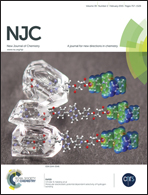Heavy metal cation and anion sensing studies of N-(2-hydroxybenzyl)-isopropylamine surface functionalized AgNPs†
Abstract
The phenolic and guest interacting functionality of N-(2-hydroxybenzyl)-isopropylamine (1) used for developing a silver nanoparticle (1-AgNP) based colorimetric sensor for metal cations (Ni2+, Co2+, Cd2+ and Ca2+) and oxalate and phosphate anions in aqueous solution. Interestingly, 1-AgNPs showed distinguishable colours for oxalate (dark grey), dihydrogen phosphate (light grey) and monohydrogen phosphate (orange). Ni2+ addition showed a clear wine-red colour whereas Co2+ showed pinkish colour. Cd2+ and Ca2+ addition resulted in orange colour formation. Absorption spectra of 1-AgNPs with metal cations and anions also exhibited selective change for metal cations (Ni2+, Co2+, Cd2+ and Ca2+) and oxalate and phosphate anions. HR-TEM studies indicate that aggregation of AgNPs due to selective metal coordination or anion interaction with surface functionality caused colour change. Differences in the aggregation led to different colours for metal cations and anions. 1-AgNPs exhibited a 10−6 M detection level for both cations and anions as well as high selectivity for Ni2+ and oxalate ions. Thus metal coordinating phenolic chelating ligands represent potential candidates for fabricating an AgNP colorimetric assay for metal cations and anions.


 Please wait while we load your content...
Please wait while we load your content...